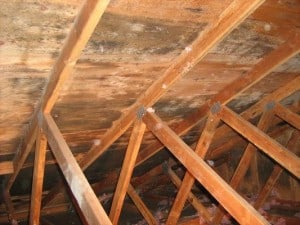Everything within a home, including the interior structure, the decorations, the belongings, the insulation, the light fixtures, televisions, sound systems, HVAC systems, and a plethora of other things can be put at risk by a leaking roof.

How does the average homeowner contemplate roof repair or replacement? Mostly when the roof is damaged by outside elements and/or when a leak is evident inside the home. Unfortunately, the deterioration of a roof could come from what is known as a “leak in process”. Simply put, the average roof leaks long before the homeowner is aware of the problem.
Having once been the CEO of the largest residential re-roofing company in the United States (22 offices in 13 states), I am aware of numerous situations where a leaking roof, though not detected internally, destroys the sheathing that supported the roof or the water from the leak became absorbed by the insulation, creating fungus and mold which often is not detected until the roof is inspected. The most common style of home has a slope roof. If water/moisture should enter at the peak of that roof it often runs down the sloping roof rafters and creates problems, i.e. the water running down the rafter connects with the plate on top of the wall and wets the underside of the eave (the overhang); the underside of which is unpainted. Or the water may filter down behind the siding which is painted on the outside and seldom on the inside, creating peeling paint. Or if it’s a synthetic siding, such as vinyl or cement, it contaminates the sheathing.
That leak can be going on for months, even years, and you’ll never know it. Which brings me to this point, “above all you need a great roof”. Contemporary materials for roofing and re-roofing have vastly improved over the years. However, the fact is when most people get a leak they rely on the roofer to recommend the weight and quality of the roof which will replace the leaking/damaged one.
Most often “the material of choice” has been asphalt. In its various forms, it is seen as the common choice for replacement. However, irrespective of how well it is made, once it is installed it falls into the category of a roof that will eventually need replacing. The truth is that you need a roof that you replace once in your life (a great roof).
When weighed purely on the basis of the lowest cost estimate you probably won’t get a one time (lifetime) roof, and most frequently owners justify this by saying “well we’re not going to live here forever”. Which raises the next issue, suppose by the time you’re ready to move that re-roofing product which you selected also shows wear/damage and a projected timeline for replacement. Remember, in today’s market when a house is sold there is usually a “home inspection” and the requirements of that inspection is to identify and advise the homeowner who may be purchasing this property of a projected timeline for replacement or at least pointing out the wear factors of the roof.
We live in a “throw away” world where planned obsolescence is a practice of many manufactures. It happens with clothing, appliances, and certainly automobiles, as well as many other things you buy. These things are manufactured to wear out eventually, that’s what keeps the “wheels of industry” moving. So why not think about a roof which meets these standards –
• A roof that will last the life of your building or to create a timeline of at least 100 years. • A roof which identifies your home as unique—well crafted—energy efficient—and increases the value of the home.
The Metal Roofing Alliance (MRA) has conducted a number of studies on how and why metal has become the most durable, efficient, attractive—and—economical roof to consider.
If you know even a little about metal roofing are you surprised at my use of the word economical? A well designed and properly installed metal roof will outlast asphalt roofs on a scale of about 6-1. Does that imply that it could last six times as long as an asphalt roof? Yes, and in fact the six time ratio is considered conservative.
My suggestion is to get to know metal roofing. It’s not the roof that was on your grandfather’s barn, nor only the standing seam metal roof which you see on commercial buildings as well as some fine homes. It is the classic roof designed to appear like slate—“hand split” shakes or tile. It is the roof of the future and it is here now.

– Dave Yoho, President, Dave Yoho Associates
www.daveyoho.com
Tags
Subscribe to American Metal Roofs's Blog


Comments